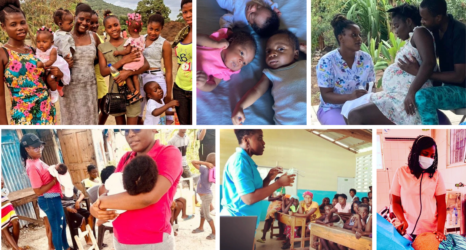Black Women’s Histories, a conversation series profiling different feminist scholars engaging Black women’s histories and narratives during Black and Women’s History Months (February and March, respectively), concludes with Talitha L. LeFlouria, author of the forthcoming Chained in Silence: Black Women and Convict Labor in the New South, due out next month. LeFlouria is assistant professor of history at Florida Atlantic University.
Your new book is quite timely in terms of mass incarceration and the criminalization of Black communities, as we’ve recently seen with racial profiling, police violence and the unrest that occurred in Ferguson. I was wondering how your book relates to these overall issues, even though it’s set during a particular time period.
When I was writing this book, I realized that many of the socioeconomic factors that these Black women faced in the post-bellum era are very similar to what we’re facing today. These women from the past were impoverished, illiterate or semi-literate. Some came from physically abusive backgrounds since some were former slaves, and even in freedom, they were targets of domestic violence. It’s very interesting how these experiences also mirror those of Black women today, those from depressed socioeconomic backgrounds. This book gives us a historical reference point to better understand Black women’s travails against the carceral state today. The book explores in particular the lived and laboring experiences of Black women prisoners in Georgia’s convict leasing and chain gang systems that emerged after the Civil War.
How did the convict leasing system and chain gangs come about during this era?
The convict leasing system emerged as a way to rebuild the war-torn Southern economy and to shift away from the agricultural economy that existed in the Old South toward the new agro-industrial economy that combined agriculture and industry. That was part of the New South promise. The only issue is that they needed labor, and they needed cheap labor in order to build up the New South. To rebuild the physical infrastructure but to also fortify new industries that existed on a small scale before the Civil War. Because Georgia possessed the most diverse range of industries, it precipitated the use of Black women in those industries. So because it had mining camps, railroads, turpentine camps, every type of industry you can imagine in addition to plantation labor, this was very different from other Southern states that relied on mono-industrial economies. And because of Georgia’s diversity, Black women found themselves in this very precarious situation where they are forced to work like men in male-dominated industries while at the same time fulfilling domestic and agricultural work roles. However, what separates convict leasing from slavery is that Black women’s reproductive bodies have no value in the post-bellum context. In slavery, their reproductive bodies were essentially the linchpin to the success of antebellum slavery, in which they gave birth to and replenished the slave labor force. But in the post-bellum context, this new system relied on conviction as opposed to conception as the means by which to grow their labor force. So there are these gendered nuances that underlie the female experience and make it somewhat different from slavery but then also in some ways worse than slavery.
What is the percentage of Black women compared to Black men in these prisons?
In the convict leasing camps, Black women typically represented three percent of the entire prison population, but represented 99 percent of the female prison population.
What were their crimes?
Over 60 percent of Black female felons were convicted for murder or attempted murder, sometimes they were convicted for arson, infanticide and in some cases for burglary, which was separate from petty theft, for which they were sent to chain gangs for 12 months.
Those statistics are troubling, especially with such high conviction rates for murder.
So many of these women were convicted for murdering abusive lovers and spouses or stepfathers. They complained that their fathers or stepfathers had “abused” them, so women who had been raped or abused physically sometimes abated their frustrations through murder.
In many ways, domestic and sexual violence is at the intersection of this Southern economy and the convict leasing system.
Absolutely. That makes Beth E. Richie’s work, Arrested Justice, even more relevant when we look at the present-day issues that Black women face and how it connects to gender entrapment and their entry into the criminal justice system.
So basically, this is not a new story. How long have you been working on this project?
I have been working on this book since spring 2004, which would make this about 11 years that I’ve been doing this research.
Why this topic of Black women in the convict lease system?
Writing this book was my way of salvaging the experiences of lesser known, less respectable Black women whose burdens and tribulations have been marginalized in the historical discourse and whose voices have been muted from the historical record. In many ways, this book is my attempt to give these women’s lives some sense of shape and to remove one link in the chain of silence that circumscribed their experiences. So for me it was a sacred duty. My great-grandmother and great-grandfather were migrants from LaGrange, Georgia. My great-grandmother lived less than five miles from the worst chain gang in the state. So my work tries to interpret her silences because she oftentimes would attempt to tell me what it was like to live in Jim Crow Georgia, but many times this telling was shrouded in silence, and I’m trying to account for her silence while also giving these women voice. This is an opportunity to honor their experiences growing up in the Jim Crow South, but it’s also a spiritual journey to let some of these women speak from the grave.
The way we foreclose on American history, and Black feminist history in particular, is demonstrated by the way we’ve created heroes and iconic figures, who are steeped in respectability. When we look at incarcerated women, how should we measure them against the politics of respectability?
These women are just as worthy of recognition as our heroes. The bottom line is: if we’re going to write Black women’s history, we’re going to have to write it from the top down and also from the bottom up. We have to honor Black women’s voices from below and to honor their struggles, and their working bodies in particular helped to build modern America. We have to look at these prisoners who were bound, unwaged, abused, and terrorized, and who also helped shape political struggles to resist the abuses, the trauma and terror, and the violence that was visited upon them. So although their resistance may have been less organized, less structured and less formal, it was still very potent and worthy of consideration.
What discoveries did you find that surprised you?
One thing that I realized in writing this book is just how much gender matters and just how much we don’t understand about this history when we ignore women. For example, what was surprising to me was the way Black female maternity was reviled in a way that it wasn’t before emancipation. We’re led to believe that the convict leasing system was “slavery by another name.” But it’s not until we look at the way women were treated that we see some of the differences and nuances. Seeing examples of some Black women giving birth in prison and then having those babies drowned in rivers, or just sometimes “disappeared,” this really resonates in what Dorothy Roberts describes as Killing the Black Body and the assault on Black women’s reproduction after emancipation. This is definitely illustrated within the context of the carceral state.
Does your book come with a trigger warning? It sounds like a painful history.
It probably should. I had to be open to use every single shred of possible data and research, including conservative newspapers that hyperbolized and pathologized Black female criminality, but at the same time gave me all of the details that I needed to pair up with the official historical records in reconstructing these women’s experiences. I’m basically refashioning a story out of second-hand data. While oftentimes their authentic voices are unaccounted for, I’ve been able to stitch together as much of their experiences and their voices without manipulating the narrative in order to allow them to speak through the silence. My book in many ways is a broken silence.
Get Ms. in your inbox! Click here to sign up for the Ms. newsletter.





